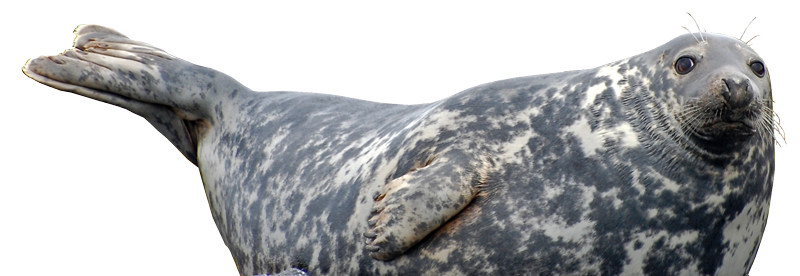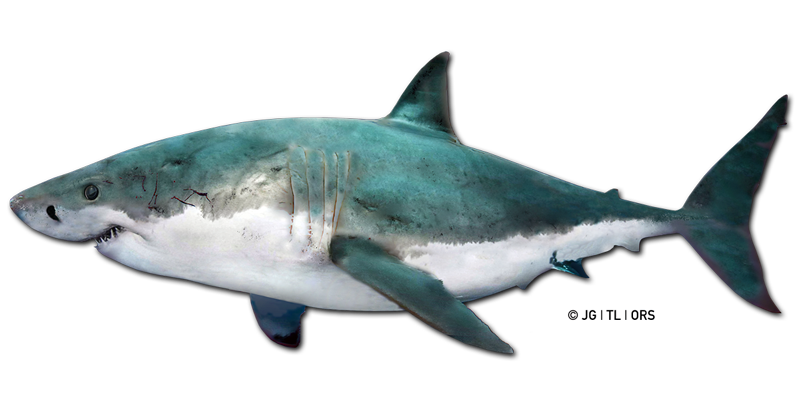| Description: A shark reportedly attacked a dory that was heavily loaded with fish at St. Peter’s Bank. The shark rammed the boat with such force that it spilled some of its contents and took on water. The boat was prevented from from sinking by the frantic bailing of its crew. The intact tooth of a white shark was recovered from the hull.
From Piers (1933):
At a meeting of the Essex Institute of Salem, Mass., on 20th April 1874, F. W. Putnam² exhibited a large tooth of a shark, who had obtained it from Andrew Johnson, one of two men who, while in a dory deeply laden with fish near “St. Peter’s Bank,” had been fiercely attacked by a large shark which bit at the dory, leaving marks of one jaw in the bottom of the boat and of the other on the side. The boat was tipped by the shark to such an extent as to spill part of the fish and to take in water and was kept afloat only by vigorous bailing. Fragments of several teeth were found in the wood. A perfect tooth from the front of the lower jaw was 1.8 inch long from the centre of its root to its point, and 2.1 inches from the extreme end of its root; while the extreme width at the base, across the root, was 1.5 inch. Samuel Garman estimated that the length of the shark was more than thirteen feet, and it was believed that the species was probably Carcharias (Prionodon) lamia or a closely allied one. This identification is not very precise, but Bigelow and Welsh refer the specimen to Carcharodon carcharias, and no doubt correctly, as such information as we possess indicates that fierce species. Unfortunately the location of the so-called St. Peter’s Bank” is not otherwise indicated by Putnam; but, although there is no fishing bank now so designated, one would naturally infer that the place referred to is the well-known St. Pierre Bank lying between about lat. 45° and 46°50′ and long. 55°20′ and 57°20′, off the south coast of Newfoundland, and which is washed by the southwestward flow of the Labrador Current. Pigeon Cove, from which Rev. D. P. Noyes sent the tooth, is without any doubt the small coastal village of that name in Essex Co., Mass., seventeen miles northeast of Salem and nearly four miles from the fishing port of Gloucester. Bigelow and Welsh complicate matters by stating that the shark had “attacked a fisherman on Banquereau Bank. That they were writing of the fish mentioned by Putnam in 1874 is quite clear from their reference to the latter’s note in the Bulletin of the Essex Institute before mentioned. One would therefore conclude that they had good cause for saying that Putnam’s “St. Peter’s Bank” was some part of the extensive and well known Banquereau, the middle of which lies in about lat. 44°30′, long. 58°20′, to the northeast of Sable Island, Nova Scotia, in which latitude we might expect to find the species on rare occasions, as a wanderer from the warm Gulf Stream. Taking all of these points into consideration, I think that the balance of evidence is very strongly in favour of the opinion that Putnam’s ‘ d St. Peter’s Bank” is St. Pierre Bank, and that in some way Dr. Bigelow must have been mistaken in referring to it as Banquereau. The southeastern end of St. Pierre Bank is, as has been said, lat. 45° (which is the same as that of the northern edge of Banquereau) and it extends northwestward to lat. 46°50’. From Banquereau it is separated by the St. Lawrence Deep. A casual specimen could easily pass out of the northern margin of the Gulf Stream, in which it had been borne northward, and wander onto the south part of St, Pierre Bank, and yet be very little north of the accidental range of the species as we now know it.
Assessment: We concur with the assessment of this incident by Piers (1933). The behaviour and physical description of the shark, the location, time of year, and circumstances of the incident, as well as the physical evidence (tooth) leave no room for doubt.
 Click here for boater recommendations. Click here for boater recommendations.
|
References:
¹ Harry Piers. (1933). Accidental Occurrence of the Man-Eater or Great White Shark, Carcharodon carcharias (Linn.) in Nova Scotian Waters. The Provincial Museum, Halifax, N.S. Proc. N.S. Inst. Sci., xviii, p.3, pp 192-203.
² Putnam, F. W. (1874). Tooth of a man-eater that attacked a dory near St. Pierre Bank. Bull Essex Inst., Salem, 6(4): 72.
|












